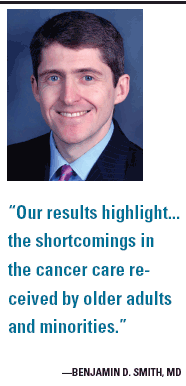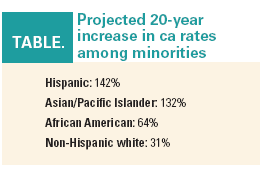ASCO draws road map to navigate economic, racial disparities in ca care
ASCO has issued policy recommendations designed to eliminate existing disparities between minorities and whites, and between those with and without health insurance. “Disparities in Cancer Care” comes as the incidence of cancer is projected to increase significantly in the next 20 years, a situation that could be catastrophic if not dealt with sooner rather than later.
ABSTRACT: The incidence of cancer is projected to surge in the U.S. as community leaders address the “profound divide” between those who have access to healthcare and those who don’t.
ASCO has issued policy recommendations designed to eliminate existing disparities between minorities and whites, and between those with and without health insurance. “Disparities in Cancer Care” comes as the incidence of cancer is projected to increase significantly in the next 20 years, a situation that could be catastrophic if not dealt with sooner rather than later.

“We have fought so hard to make really important gains in the fight against cancer and have started to see improvements in cure rates in many areas,” said Derek Raghavan, MD, PhD, cochair of ASCO’s Health Disparities Group. “We will see that slip from our grasp if we don’t function as a society to provide adequate current and appropriate healthcare for people who are somewhat disadvantaged, either financially, geographically, or by cultural impediments.”
Equal access
“Advances in cancer research have led to the development of sophisticated screening and treatment methods thereby contributing to substantial improvements in survival rates,” said Richard L. Schilsky, MD, ASCO president.
“However, there continues to be a profound divide in our nation between those with access to the improved results of our research efforts and those without access,” added Dr. Schilsky, who is a professor of medicine at the University of Chicago Medical Center.
Dr. Raghavan outlined the components of the ASCO statement, which calls for increased efforts in the following areas:
• Research into the differences in quality of care provided to minorities vs whites
• Research on the factors contributing to poorer quality of care
• Enrollment of minorities in clinical trials
• Diversity of the oncology workforce to provide more culturally appropriate care
• Encouragement for oncologists to practice in underserved areas
• Development of policies to guarantee equal access to quality healthcare, with an emphasis on insurance coverage and reduced economic barriers to cancer care
“Developing policies to guarantee equal access to quality healthcare is a critical factor. Lack of insurance is a huge barrier to improving cancer care and survival in the U.S.,” commented Dr. Raghavan, who is the chair and director of Taussig Cancer Center at the Cleveland Clinic.
“A reformed system should ensure comprehensive, coordinated treatment for people living with cancer and eliminate barriers to important screening services that allow us to detect cancers earlier and prevent recurrence and, thus, improve outcomes,” he said.

The total number of cancers diagnosed in the U.S. will increase by 45% in the next two decades, from 1.6 million cancers to 2.3 million cancers, said Benjamin D. Smith, MD, chief of radiation oncology at Wilford Hall Medical Center at the Lackland Air Force Base in San Antonio.
Dr. Smith studied demographic trends using the SEER database and population projections from the U.S. census bureau to estimate the total number of cancers that will be diagnosed in the U.S. from 2010 to 2030. His coinvestigators are from Houston’s M.D. Anderson Cancer Center and the City of Hope Cancer Center in Duarte, Calif.
This increase will be driven by new cancers in adults over the age of 65 and in minorities, Dr. Smith said (see Table). The total number of cancers diagnosed in older adults will increase by 67%, from 1 million to 1.6 million, and the total number of cancers diagnosed in minorities will increase by 100%, from 330,000 to 660,000 (J Clin Oncol online, April 29, 2009). “Our results highlight the urgency of addressing shortcomings in the cancer care received by older adults and minorities,” Dr. Smith said.
Dr. Raghavan called these statistics “very strong and inescapable. Although we may not quite reach the cancer figures projected by Dr. Smith and colleagues, we’ve known for a long time that we would have an emerging group of aging baby boomers.”
“We also know that the population of minorities in this country has increased, and that there are increasing problems that relate to unemployment and lack of health insurance,” he added. Visit www.asco.org for resources on health disparities, such as educational opportunities, avenues of research, and relevant publications.
2 Commerce Drive
Cranbury, NJ 08512
All rights reserved.